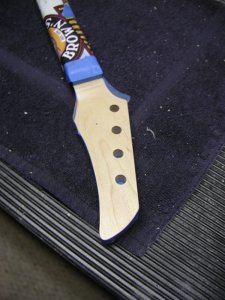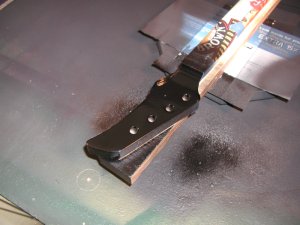Finishing
One thing I especially like about the bolt on neck is that itís very easy to finish the neck and body in completely different ways. Unlike a neck thru instrument, I was able to easily finish the neck with clear lacquer and the body with black lacquer without what could be an awkward and sudden break between the two finishes.
Paint Booth
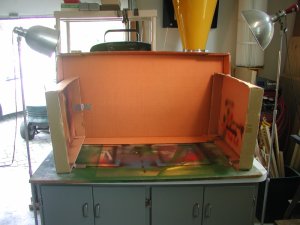 I made an impromptu paint booth using a bunch of cardboard boxes to catch overspray. (And there will be overspray! By the time I finished everything was covered in a thick layer of dried paint dust.) For ventilation, I left at least one of the garage doors open. The window on the opposite side of the booth was also left open with a fan blowing out for cross ventilation. This stuff is really nasty to breath, especially the deft lacquer. So much so that even with good ventilation you pretty much have to wear a respirator. After a few seconds of spraying, the fumes saturate the air above whatever you are painting to the point where you pretty much have to run for clean air or risk suffocation.
I made an impromptu paint booth using a bunch of cardboard boxes to catch overspray. (And there will be overspray! By the time I finished everything was covered in a thick layer of dried paint dust.) For ventilation, I left at least one of the garage doors open. The window on the opposite side of the booth was also left open with a fan blowing out for cross ventilation. This stuff is really nasty to breath, especially the deft lacquer. So much so that even with good ventilation you pretty much have to wear a respirator. After a few seconds of spraying, the fumes saturate the air above whatever you are painting to the point where you pretty much have to run for clean air or risk suffocation.
Humidity
All of the painting products I used required that the humidity be below 60%. In the winter Iím sure this is almost never a problem in the northeast where I live, but the summer is a different story. According to a new humidity meter I just got, the humidity has been hovering just below 60% for the past week, and thatís inside. I only stopped painting one afternoon when it started to rain and the humidity was obviously too high. Even so, the paint job came out ok: I was just forced to take my chances and hope for the best while getting there.
Finishing the Neck
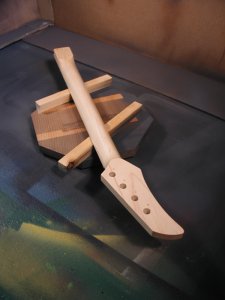 The neck was coated about four times in Deft gloss lacquer with about 30 minutes between each coat. Since their isnít any good way to hold the neck while still coating the entire piece at one time, I used a board to lay the neck upside down on the uncoated frets to dry. For each coat, I would coat the top of the headstock first then flip the neck over and coat the entire back surface of the neck, the back and sides of the headstock and the bottom and rear of the heel. I didnít coat the fretboard after I fretted it even though I have heard of people adding finish with the frets installed then using steel wool to remove any lacquer that lands on the frets. About an hour after the last coat was applied (more time wouldnít hurt) I was able to buff out the finish with 0000 steel wool to a satin sheen. I like a satin sheen on the neck since itís more slippery so you can move around the neck faster.
The neck was coated about four times in Deft gloss lacquer with about 30 minutes between each coat. Since their isnít any good way to hold the neck while still coating the entire piece at one time, I used a board to lay the neck upside down on the uncoated frets to dry. For each coat, I would coat the top of the headstock first then flip the neck over and coat the entire back surface of the neck, the back and sides of the headstock and the bottom and rear of the heel. I didnít coat the fretboard after I fretted it even though I have heard of people adding finish with the frets installed then using steel wool to remove any lacquer that lands on the frets. About an hour after the last coat was applied (more time wouldnít hurt) I was able to buff out the finish with 0000 steel wool to a satin sheen. I like a satin sheen on the neck since itís more slippery so you can move around the neck faster.
Paint it Black
I was originally going to paint headstock black. I applied the same black color coat over the clear Deft, which I had tested earlier and seemed to work. The earlier test makes me think this was not necessarily a bad way to do it (but this would not be the way I would do it next time.) I applied clear coats over the color for a glossy finish that would match the body.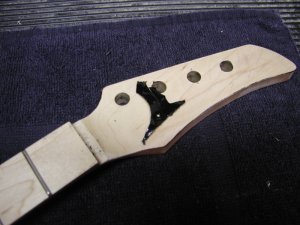 Due to the way I taped off the sides, the paint pealed away leaving a nasty edge. I should have taped the sides off so that the tape didnít extend above the sides. It wasnít a complete tragedy because I was able to very easily peel the finish off without chemicals or heavy sanding. It came off cleanly to the bare wood using a sharp needle file that I used to dig under the finish and then peel the layer of finish off (it couldnít be a good sign that it came off that easily.) I then sanded the bare wood until it was flat and smooth. I was able to recoat the top of the peghead with clear Deft lacquer leaving no clue that the peghead was ever painted black.
Due to the way I taped off the sides, the paint pealed away leaving a nasty edge. I should have taped the sides off so that the tape didnít extend above the sides. It wasnít a complete tragedy because I was able to very easily peel the finish off without chemicals or heavy sanding. It came off cleanly to the bare wood using a sharp needle file that I used to dig under the finish and then peel the layer of finish off (it couldnít be a good sign that it came off that easily.) I then sanded the bare wood until it was flat and smooth. I was able to recoat the top of the peghead with clear Deft lacquer leaving no clue that the peghead was ever painted black.
